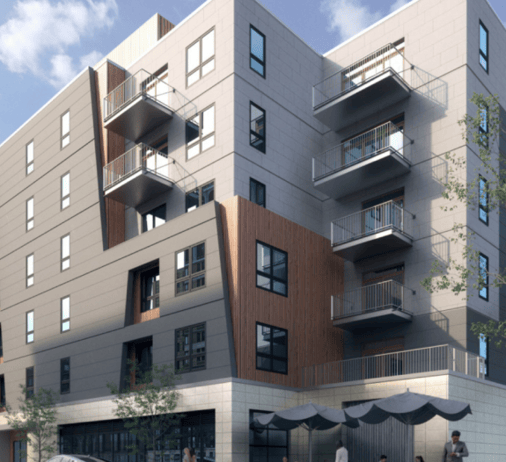Can Fenway Center succeed where Columbus Center has not (so far)?

(rendering of One Kenmore aka Fenway Center)
Fenway Center, the 1.3 million square foot mixed use project seen in the drawing above, has been in the works since 1996, in various incarnations, with the most recent plan being:
The Parcel 7 Fenway Center Development will be located over the Mass Turnpike and on a surface parking lot between the Beacon Street and Brookline Avenue bridges.
The proposed Fenway Center development is a “Smart Growth” transit-oriented development that will locate approximately 300 residences, offices and neighborhood oriented retail space directly adjacent to a new Yawkey Commuter Rail Station, one block from the MBTA’s Kenmore Square and Fenway Green Line Stations. (from the development webpage)
After more than a decade of planning and revisions, the news is positive. The project should receive final permitting next year (although I can only hope given the absurd development process in Boston - who knows what monkey wrench could be tossed in at the last minute) and funding is in place for the MBTA rail station improvements required for the project. John Rosenthal, developer of the project, was interviewed in this week's Banker and Tradesman about the project.
Q:In this market, does working on a longer timeline wind up helping you out?
A: As hard as it’s been to weather a decade of planning and permitting, we just may luck out with the timing. Everyone in real estate knows that a lot of our successes or failures are based on luck and timing – neither of which we can control. There are at least two things going for us: We won’t be seeking financing for 12-18 months, and construction costs are softening.
Q: What makes Fenway Center special?
A: Fenway Center will be where the pebble drops for smart growth and transit-oriented development in Boston. We have a tremendous opportunity to improve pedestrian realm and public circulation. The fact that we’re turning underutilized, inaccessible surface parking lots and long expanses of windswept bridges, and covering the loud, smelly Turnpike and rail corridor with energy-efficient, mixed-use buildings – incredibly attractive buildings, architecturally, surrounding a multimodal transit center – it’s as great an opportunity as could exist. Not to mention the proximity to Fenway Park, to Longwood, to the Back Bay and Brookline. The infrastructure already exists. The demographics already exist. I would pick this site all day long over any site in Boston.
Q: Everybody talks about this project in terms of Fenway and Kenmore. But you think Longwood is what makes it work?
A: This is really about the Longwood Medical Area. It’s the largest economic engine in the state. The point of the [2006 economic] stimulus package was to make it easier to get to the Longwood Medical Area without driving. That’s what Yawkey Station is all about.
Q: What have you learned from watching Columbus Center come unglued? And has it made you wary of building an air rights project?
A: Pioneers often end up with arrows in their backs, and Columbus Center certainly did a lot of pioneering. But the two sites are night-and-day-different. You can’t even compare them. Ours is eminently more developable, and at a lower cost. All air rights sites are not created equally. The ratio of land to air is critical. And there’s a critical relationship between how much deck you create and the density you need to pay for it. We have similar square footage to Columbus Center planned, but we only have 94,000 square feet of deck; they have 150,000 square feet on multiple decks and multiple bridges. That’s a huge difference.
Q: State subsidies were a flashpoint for them. Can you build your deck on your own?
A: I hope so. It’s our goal. It won’t be easy, but, fortunately, the majority of our deck platform is a lightweight parking garage that does not require heavy foundation elements. Our tallest building was shifted onto air during the public process, but it has a relatively small footprint. It’s a balancing act, but I believe we can get it done.
With this project and several others in the works (some of which I wrote about here), I am very excited for the Fenway/Kenmore neighborhood as a place to live and as an investment - both now and in the future. Mark my words, Fenway/Kenmore will be THE place to live in 5-7 years.
